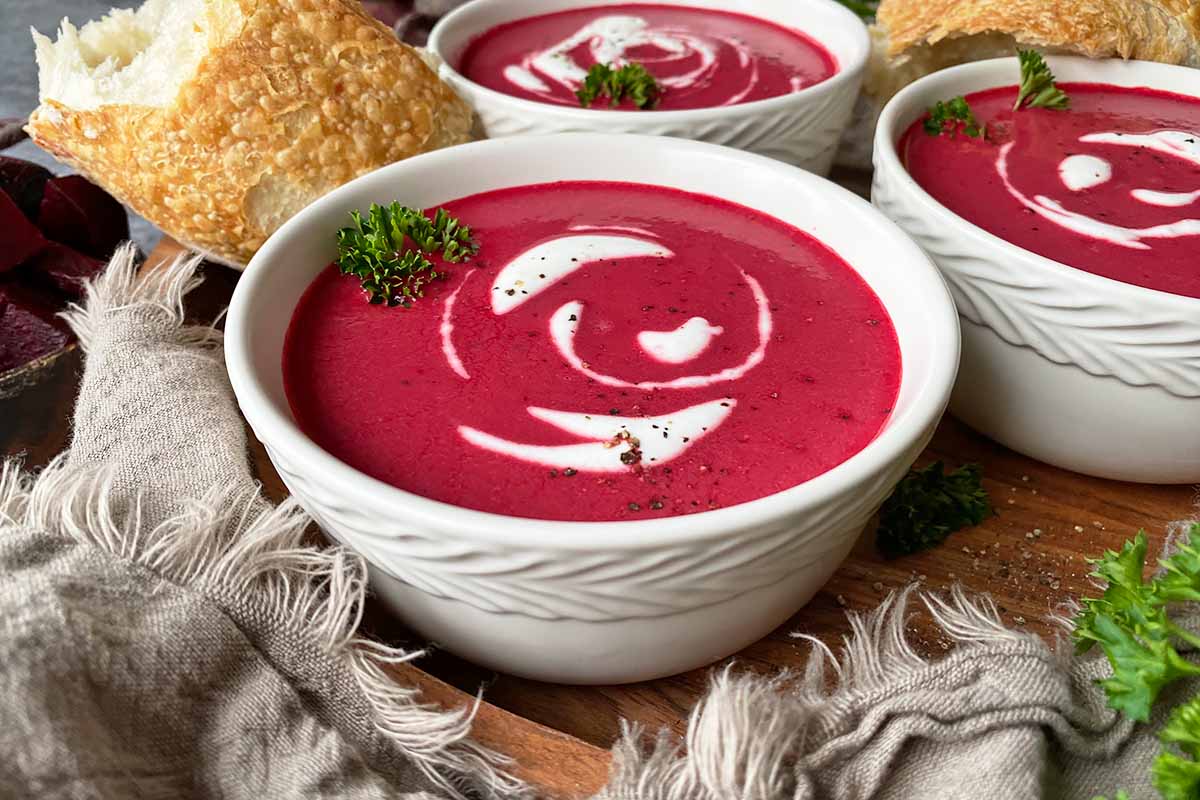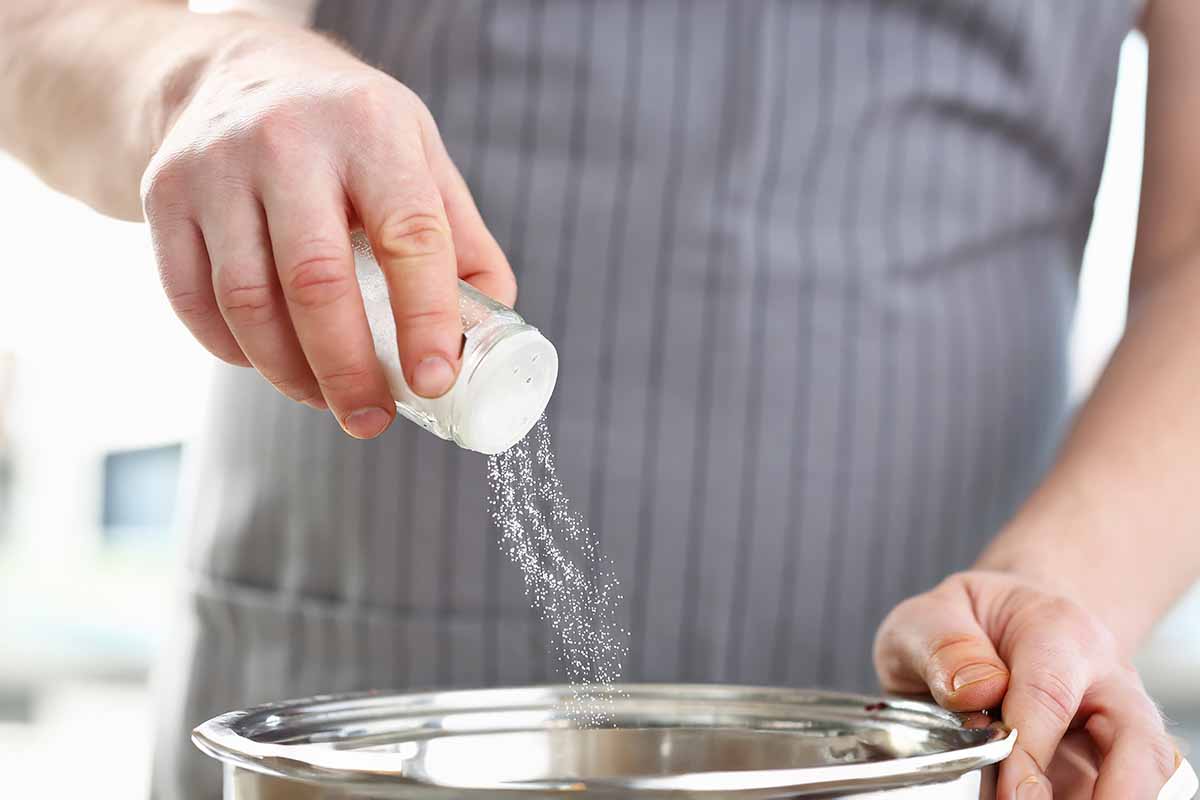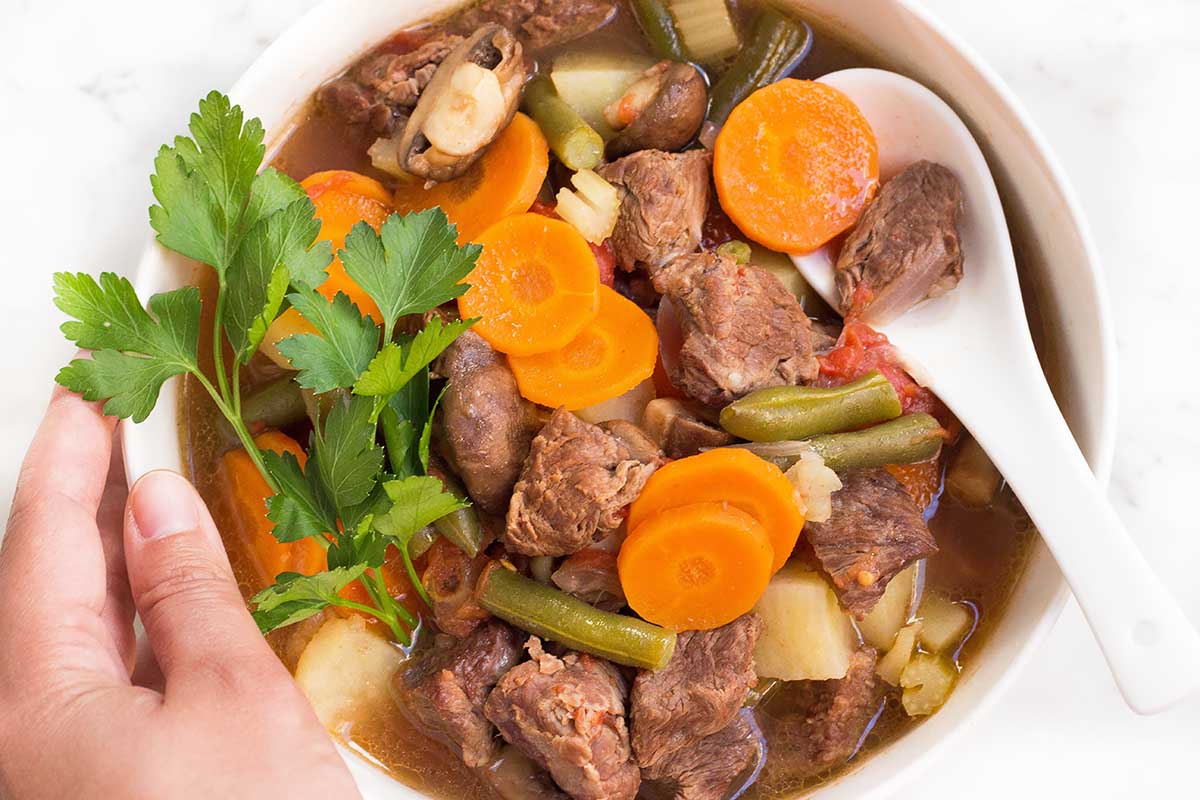Soggy bread. You in?

Yes, you heard me! Soft, soggy, soppy, mushy bread.
In most home kitchens, this is considered the ultimate fail when it comes to serving carbs.
No one should have to hold limp crostini or bruschetta. And garlic bread should be crunchy and toasty! And who really wants their bread basket to be filled with… wet bread?
But soggy bread can actually be a good thing. No joke.
You’ve seen it before in many gazpacho recipes, and French onion soup often has a hearty slice floating on top, soaking in all that wondrous beef broth.
And when this popular soup comes in, unabashedly strutting its savory stuff, mushy bread is an essential component of the base.
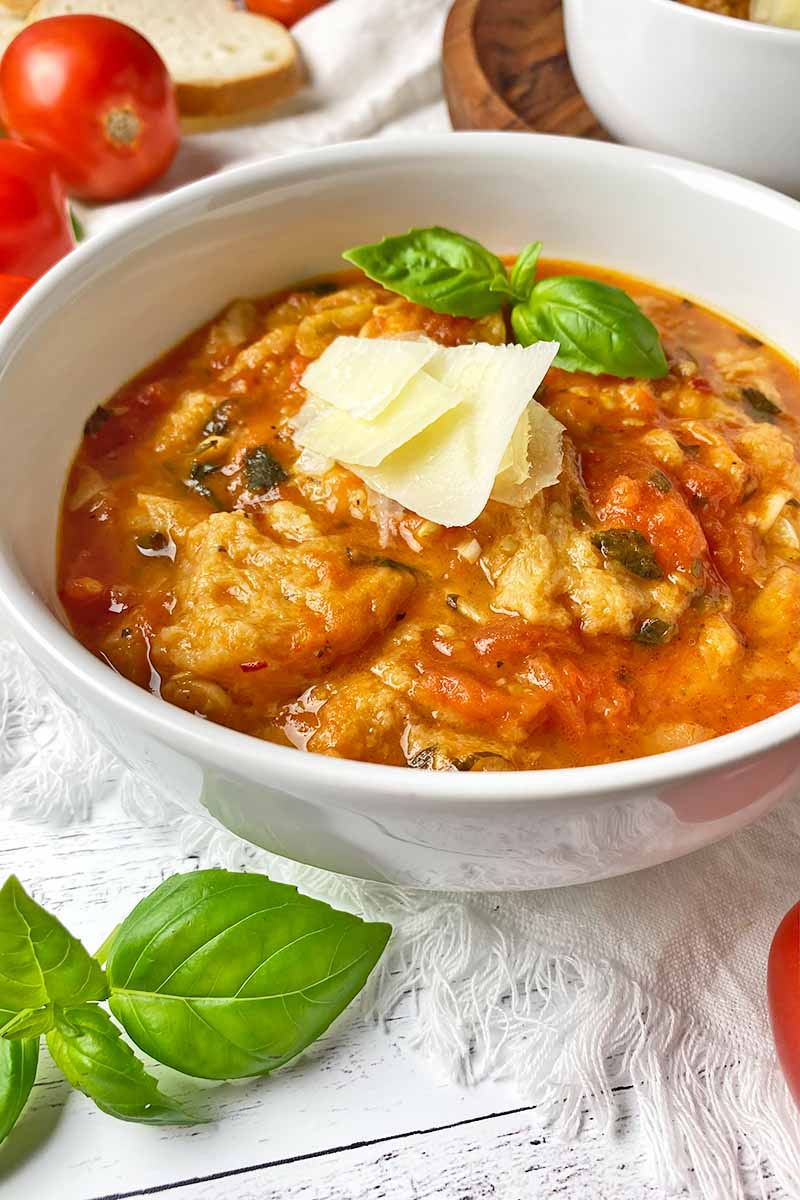
Italian tomato and bread soup, known as pappa al pomodoro, lovingly demands that the bread is stewed until it’s soft and soggy.
For further insight into this unique cooking technique, it’s all in the name itself!
Pappa al pomodoro loosely translates to “tomato mush.” The word pappa in Italian is used in reference to baby food, or any food in general that is soft and easy to chew.
But this rustic vegetarian soup is far better than pureed baby food, I promise you – perfect for the grownups of the family!
Simple and fresh, tomato and bread soup has a short ingredient list that combines the best produce with aromatics like floral basil leaves and pungent garlic cloves.
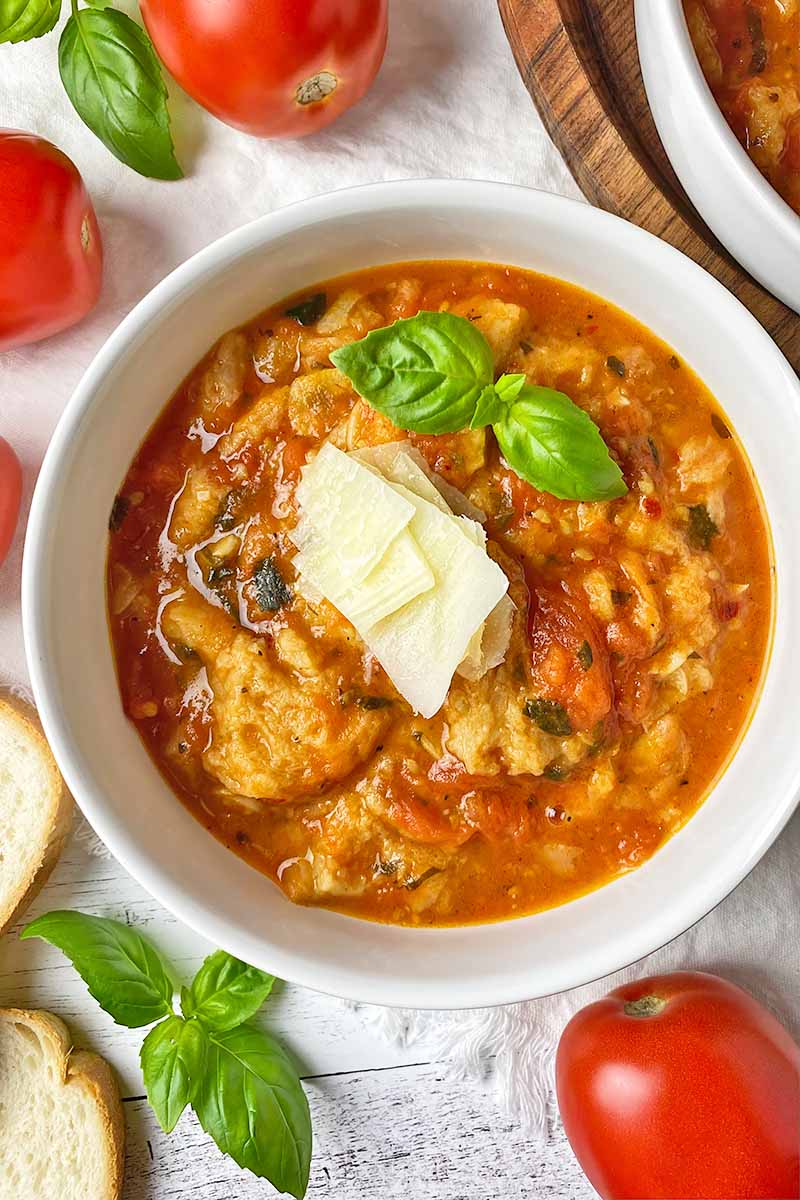
Once you warm minced garlic and red pepper flakes in olive oil until irresistibly fragrant – to the point that you just want to dip your baked loaf in the oil instead of carrying on with the recipe – you then recompose your sense of self-discipline and move forward.
After briefly cooking peeled fresh plum tomatoes in this to-good-to-be-true oil, you then add cubes of stale or toasted crusty bread, and let them absorb all that juicy fun.
With the addition of your favorite vegetable stock, after you let all the ingredients simmer and get to know one another in the Italian oasis that is your soup pot, you have yourself a warm and comforting soup with a soft, slurp-worthy texture.
A simple soup needs a simple, yet impactful, garnish to match. Shaved Parmigiano Reggiano or Pecorino Romano and a few of the prettiest leaves of basil are all you need!
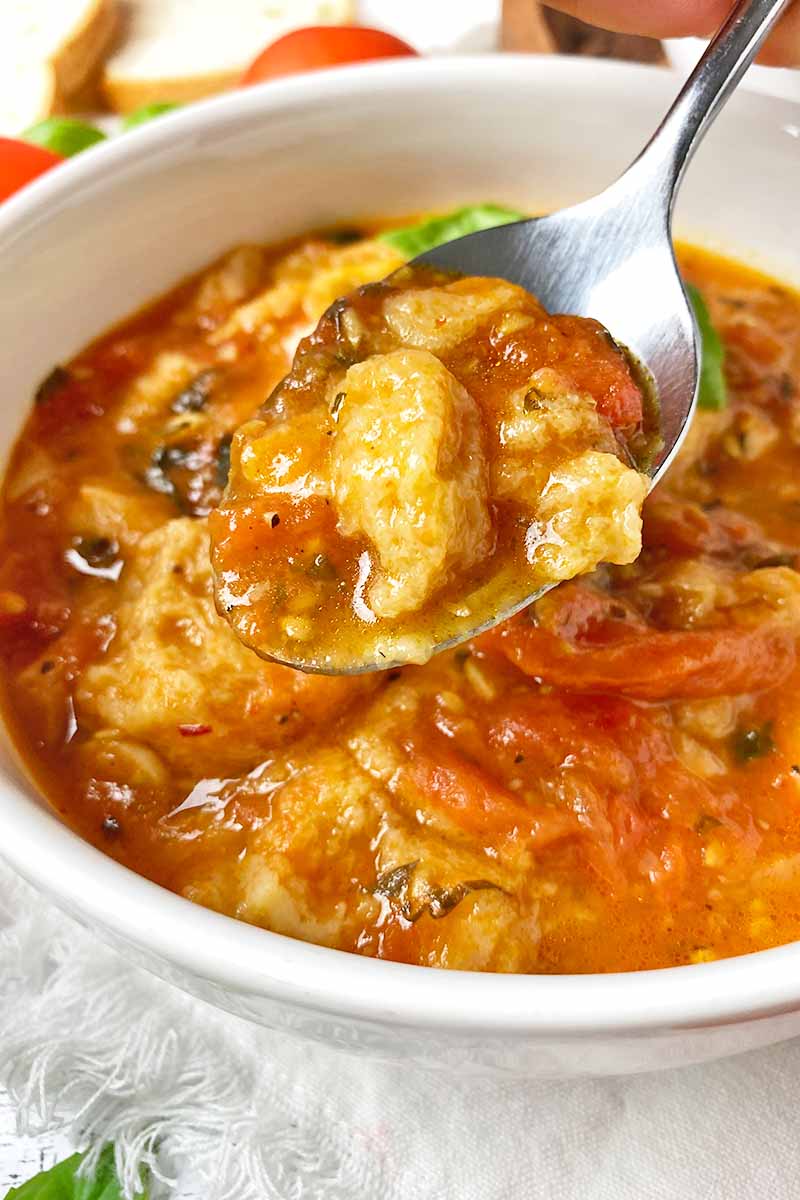
And who knows – after enjoying a big bowlful of this soup, soggy bread might be your new favorite thing.
Not a fail!
Print
Italian Tomato and Bread Soup (Pappa al Pomodoro)
- Total Time: 1 hour
- Yield: 4 servings 1x
Description
Pappa al pomodoro is an Italian tomato and bread soup, made by cooking together simple ingredients to yield a soft and slurp-worthy texture.
Ingredients
- 2 pounds ripe plum tomatoes
- 3 tablespoons olive oil
- 4 large cloves garlic, thinly sliced
- 1/2 teaspoon red pepper flakes
- 2 teaspoons coarse kosher salt, plus more to taste
- 1/2 teaspoon cracked black peppercorns, plus more to taste
- 4 ounces stale or lightly toasted rustic bread (about 1/4 loaf or 4–5 slices), cut into 1/2-inch cubes
- 2 cups vegetable stock, plus more as needed
- 1/4 cup freshly chopped basil, plus more leaves for serving
- Shaved Parmigiano Reggiano or Pecorino Romano, for serving
Instructions
- Bring a large pot of water to a boil over high heat on the stovetop. Prepare an ice bath in a large bowl.
- Cut shallow X-shaped slits through the skin on the bottom of each plum tomato with a sharp paring knife.
- Using a large slotted spoon, carefully submerge the tomatoes into the boiling water. Blanch for about 1 minute. With the same slotted spoon, immediately transfer the tomatoes to the ice bath. Allow them to cool for about 5 minutes.
- Remove and discard the core from each tomato. Peel off and discard the skin. Quarter each tomato, saving any juice and seeds.
- In a large pot, heat the olive oil over medium-low heat. Add the garlic and red pepper flakes and gently warm until aromatic for 1-2 minutes without browning, stirring constantly.
- Add the tomatoes, seeds, and juice to the pot, and raise the heat to medium. Cook the tomatoes for 10-15 minutes, stirring and crushing occasionally with a sturdy spoon or spatula, until most of the juices have been released and the liquid is slightly thickened. Add the salt and black pepper and briefly stir again.
- Add the bread cubes and stir constantly until the bread absorbs some of the liquid, about 5 minutes.
- Stir in the vegetable stock and basil. Bring the soup to a boil, then reduce the heat to a simmer. Continue simmering until the liquid slightly reduces and the bread is completely soft, stirring occasionally, about 10 to 15 minutes. Add more stock as needed if the mixture is too thick – it should have the consistency of a thick soup.
- Season to taste with salt and pepper before dividing the soup among bowls and garnishing with shaved cheese and basil leaves. Serve warm.
- Prep Time: 30 minutes
- Cook Time: 25 minutes
- Category: Soup
- Method: Stovetop
- Cuisine: Italian
Keywords: Italian, tomato, bread, soup, pappa al pomodoro
Cooking by the Numbers…
Step 1 – Prep and Measure
Fill a large pot with water and bring it to a boil – you’ll use this to blanch your tomatoes.
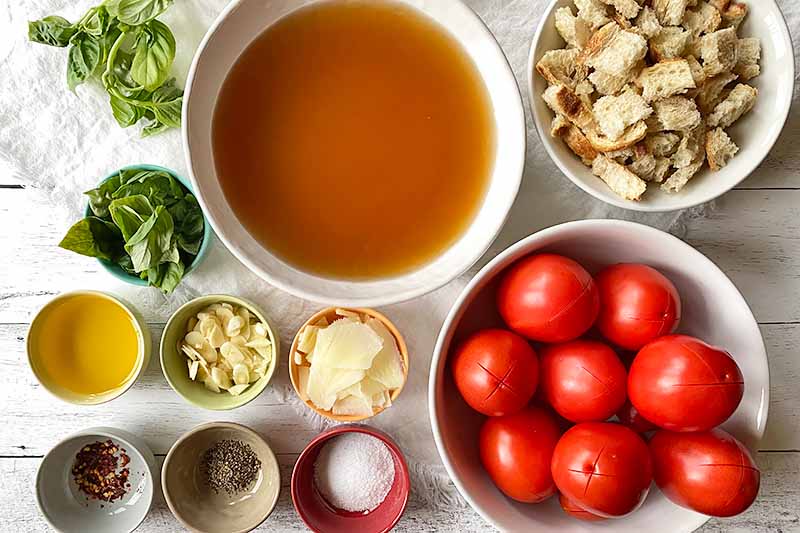
You’ll also need to prepare an ice bath to shock the blanched tomatoes and stop the cooking process. For this, simply fill a large bowl with ice and water.
Measure out the olive oil, red pepper flakes, and vegetable stock. Grind the kosher salt and crack the black peppercorns.
Be sure to have extra vegetable stock on hand – the bread may absorb more liquid than anticipated, so you might need to add more. In a pinch, you can use water.
Cut your stale bread into 1/2-inch cubes. Any crusty, rustic white loaf will do. Keep in mind that a sourdough style will give this recipe a subtly tangier taste. And the often-ignored ends of your loaf will be perfect for this, a strategic way to use up the entire loaf of bread!
If the loaf is fresh and not stale, cut it into cubes, and place them in an even layer on a baking sheet. Toast the cubes in the oven at 275°F for 15 to 20 minutes, or until dry to the touch.
Thinly slice the garlic cloves, using a sharp knife and a sturdy cutting board.
Chop fresh basil leaves, setting aside a few of the prettier leaves to use when you’re ready to garnish and serve.
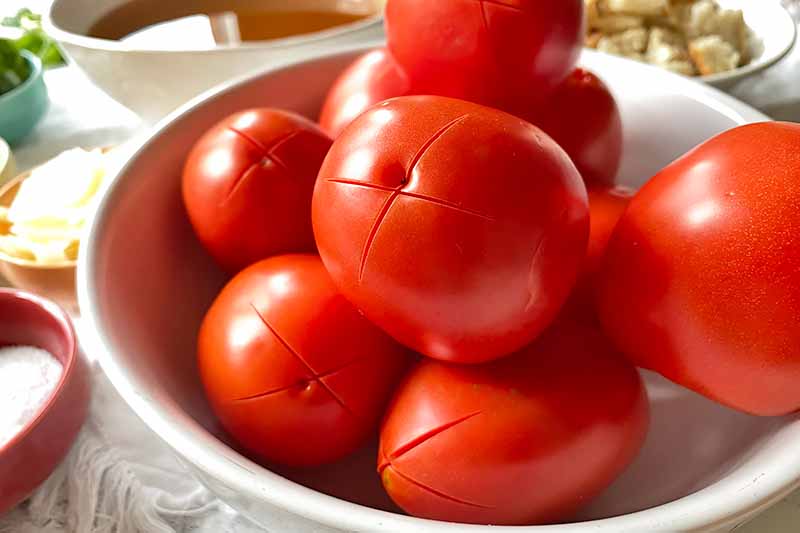
If using, thinly shave a little Parmigiano Reggiano or Pecorino Romano – no specific measurements here! Prep however much you want to have available to garnish each bowlful.
With a sharp paring knife, slice shallow X-shaped slits through the skin on the bottom of each tomato. Scoring the skin will help it release from the flesh more easily when blanching.
Step 2 – Blanch Tomatoes
Gently place the prepped tomatoes into the boiling water.
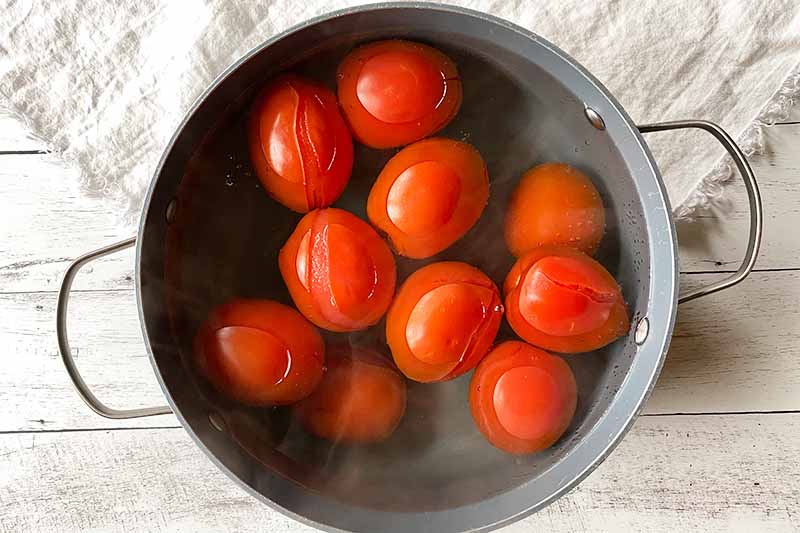
Using a slotted spoon for this task will make it easy to transfer them in and out of the boiling water without running the risk of splashing hot water on yourself.
Let them boil for 1 minute – they don’t need a lot of time for the skin to start releasing! You can start checking at 30 seconds for signs that the skin is starting to peel away.
Immediately remove the tomatoes from the pot and transfer to the ice bath. Allow them to cool for about 5 minutes in the bath.
Step 3 – Remove the Core and Skins and Quarter
Using a paring knife, cut out and dispose of the core from each tomato. The core is usually pretty shallow, so be careful not to take too much of the flesh with it!
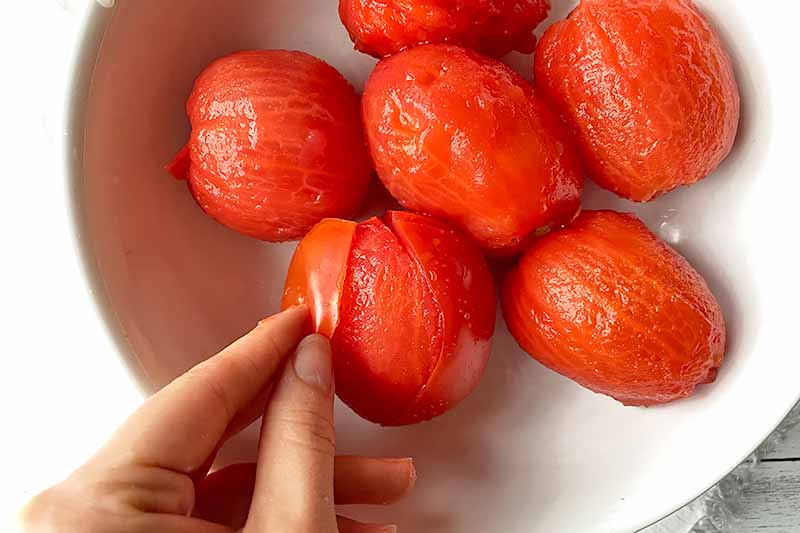
Either with your fingers or the tip of your paring knife, peel the skin from the fruit. It should come off very quickly and easily. Discard the skins.
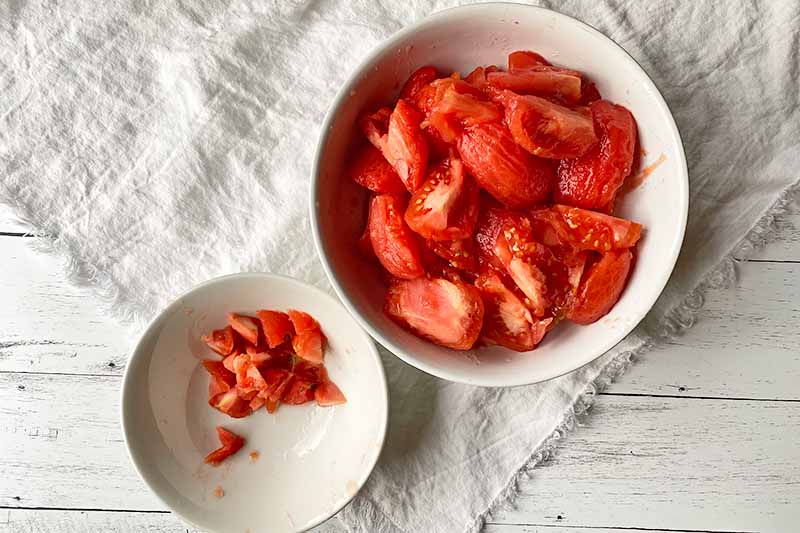
Quarter each peeled tomato, and save all the seeds and juice that spill out. This isn’t a concasse technique, where you dispose of the juice and seeds. You want alllllll that goodness to go in your soup!
Step 4 – Warm the Garlic and Red Pepper Flakes
In a large pot – you can use the same one you blanched the tomatoes in – heat the olive oil over medium-low heat. You do not want the olive oil to get too hot, or you may risk burning your garlic and red pepper flakes, making them bitter.
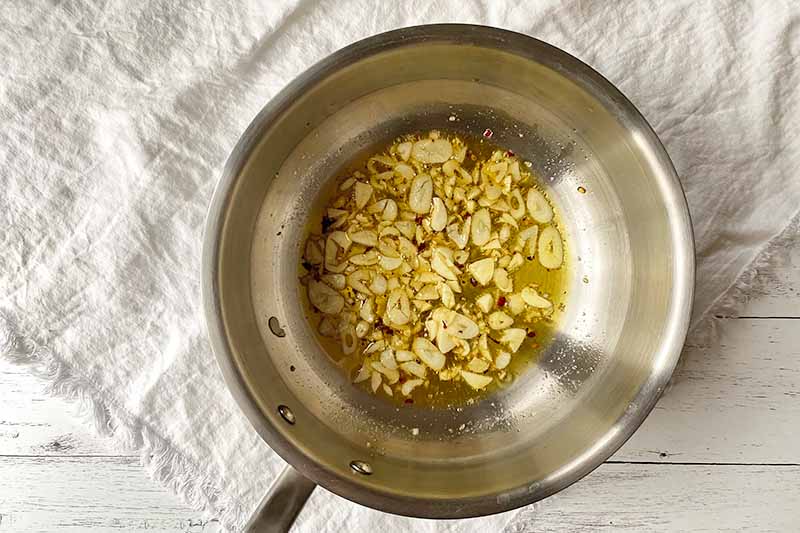
Add the garlic and red pepper flakes and gently warm them for about 1 to 2 minutes without browning. The garlic will be very aromatic, but it should not be brown. This is the perfect point to move on to the next step!
You can leave out the red pepper flakes if you don’t like too much spicy heat in your food.
Step 5 – Cook the Tomatoes
Add the tomatoes and any seeds and juices you reserved to the pot. Raise the heat to medium.

Cook the tomatoes for 10 to 15 minute to thicken the mixture just slightly. Stir and crush the tomatoes occasionally with a sturdy spoon or spatula throughout this time. Most of the juices will be released from the tomatoes during this step.
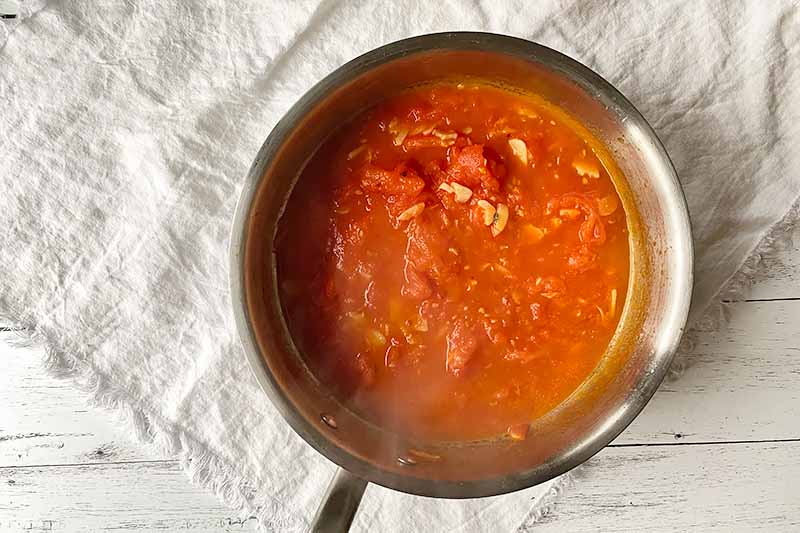
When thickened, add the salt and black pepper and briefly stir again to incorporate the seasonings evenly.
Step 6 – Soften the Bread
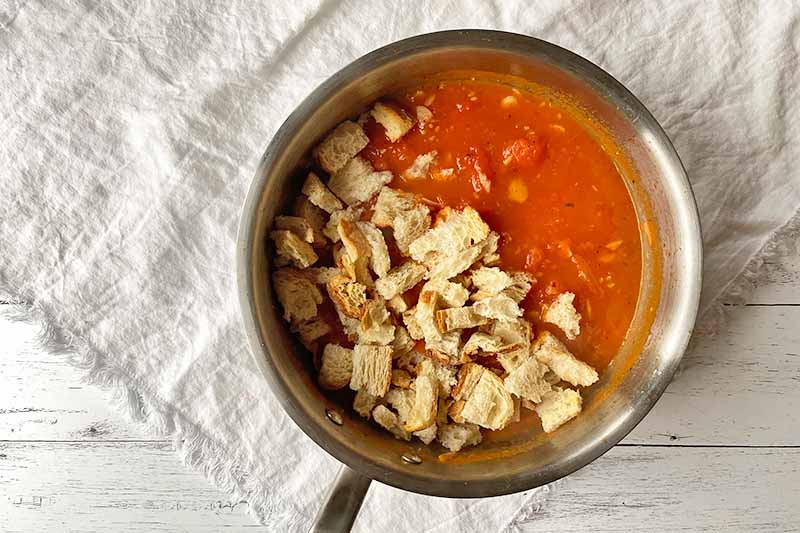
Add the bread cubes to the pot with the tomatoes. Stir constantly until the bread has softened and has absorbed some of the liquid, for about 5 minutes.
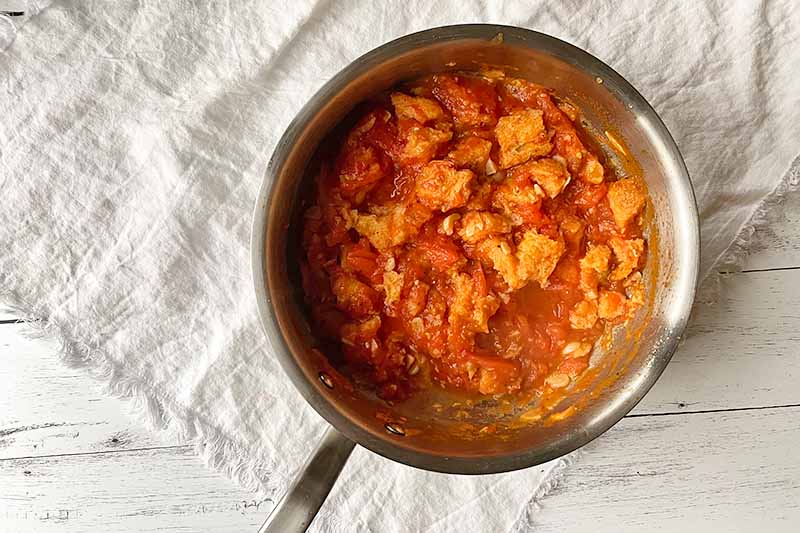
And let me remind you now that the bread is supposed to get soft and soggy!
Step 7 – Add Stock and Basil and Cook
Add the vegetable stock and basil and stir it in. Bring the soup to a boil, then reduce the heat to a simmer.
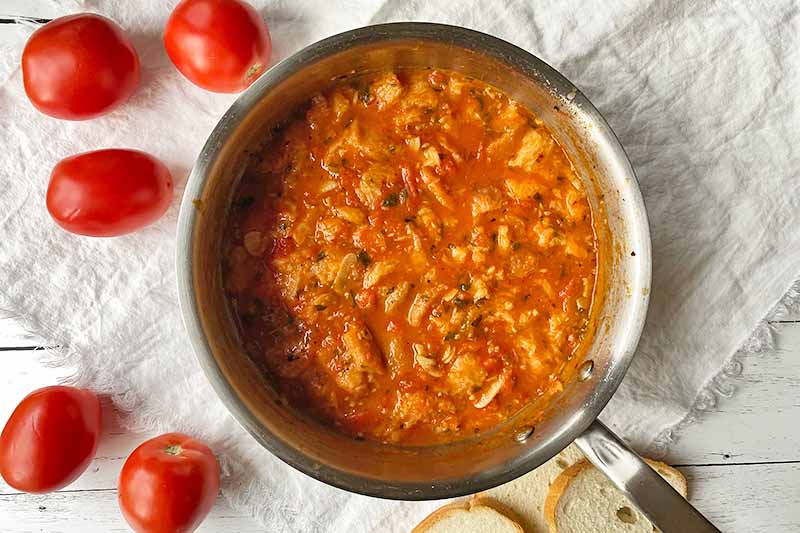
If you prefer a more savory, meatier flavor, you can use an equal amount of chicken stock. But if you want to keep this dish vegetarian, stick with the vegetable stock. You can also use water instead of stock, if you don’t have any on hand – to add more flavor, you may need to adjust the salt content.
Continue simmering for another 10 to 15 minutes, until the soup slightly reduces and the bread is completely soft and very mushy. It will almost look like it has melted into the liquid.
Stir occasionally to prevent anything from sticking to the bottom or sides of the pot.
You may need to add more stock if the bread has absorbed too much liquid and the mixture seems to be too thick. Ideally, the finished soup should have a thick consistency, with enough liquid for each serving.
Step 8 – Garnish and Serve
Check the seasoning before you serve. Stir in additional salt or pepper as needed. For more heat, add a few more shakes of red pepper flakes.
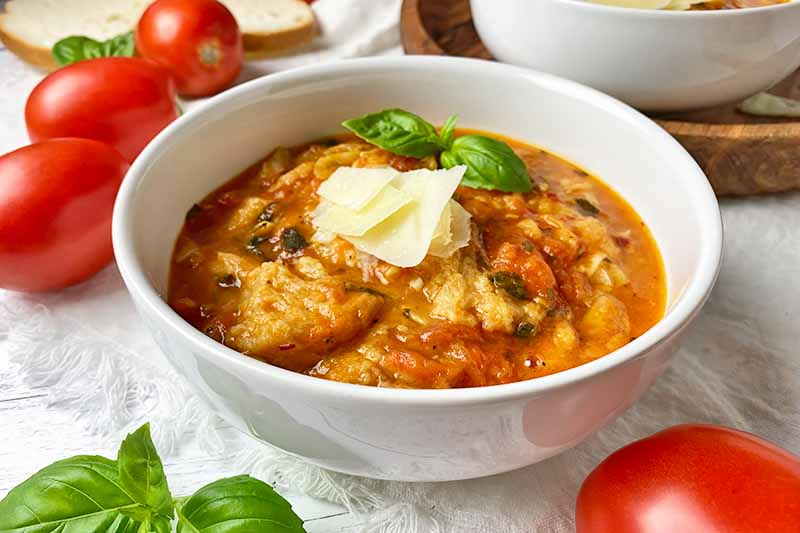
Divide the soup between four bowls and garnish with the shaved cheese and basil leaves. Serve and enjoy while it’s warm on its own or as part of a full-course Italian meal!
Canned Toms: The Next Best Option
If you don’t have fresh and flavorful tomatoes available, if the last crop you grew was a little bland, or if you really don’t feel like going through all the steps of blanching and peeling, you can still enjoy the comfort and joy of this recipe with a quick substitution:
Canned tomatoes!

Instead of two pounds of fresh produce, use one 28-ounce can of whole peeled plum tomatoes. Because these tomatoes will be softer than fresh, you can crush them gently with your hands or use kitchen shears to cut them while they are still in the can before adding them to your soup pot to cook.
And don’t you dare throw away any of the juices they are packed in! Make sure you are adding all of the liquid from the can into the pot.
I learned a valuable lesson from my grandmother regarding this step:
Whenever she would make sauce or soup, she would always swirl a splash or two of water in the can after she dumped the contents to get every little tomato bit out entirely – absolutely nothing went to waste!
So feel free to do as the nonnas do and use the same technique in this case. A small amount of extra liquid won’t harm the soup, and the bread will love to absorb it!
What do you think of this recipe? Are you a fan, or not, of its soft and perfectly gummy texture? Let me know your thoughts, good or bad, in the comment section below.
All I ask is that you don’t judge too quickly or harshly – give it a try at least once!
Calling all my fellow garlic lovers! We can never get enough, am I right? If you haven’t already snuck in the rest of the bulb in this soup, save those cloves for another recipe. Ready the garlic press, and make these recipes next. Oh, and grab some mints for later…
Photos by Nikki Cervone, © Ask the Experts, LLC. ALL RIGHTS RESERVED. See our TOS for more details. Originally published on November 17, 2014. Last updated on March 24, 2023.
Nutritional information derived from a database of known generic and branded foods and ingredients and was not compiled by a registered dietitian or submitted for lab testing. It should be viewed as an approximation.
About Nikki Cervone
Nikki Cervone is an ACS Certified Cheese Professional and cheesemonger living in Pittsburgh. Nikki holds an AAS in baking/pastry from Westmoreland County Community College, a BA in Communications from Duquesne University, and an MLA in Gastronomy from Boston University. When she's not nibbling on her favorite cheeses or testing a batch of cupcakes, Nikki enjoys a healthy dose of yoga, wine, hiking, singing in the shower, and chocolate. Lots of chocolate.


